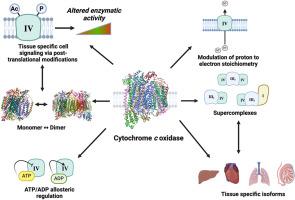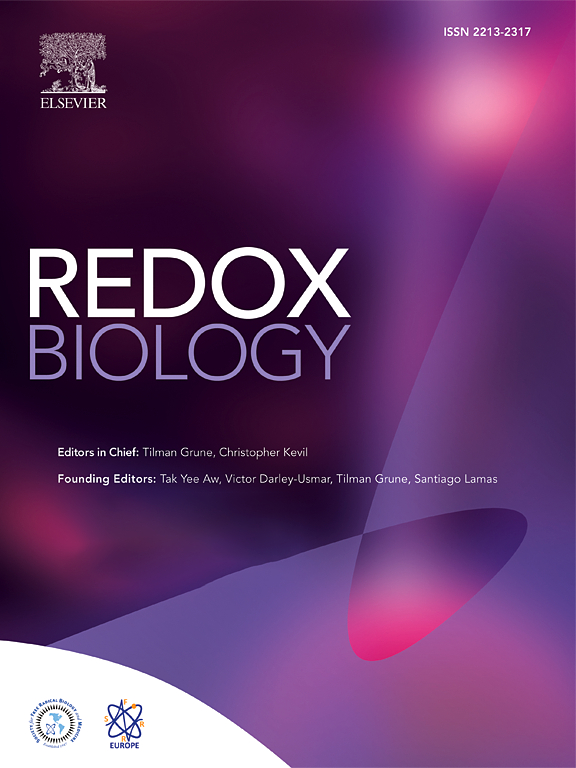在健康和疾病中通过严格控制细胞色素 c 氧化酶调节线粒体氧化磷酸化--对缺血/再灌注损伤、炎症性疾病、糖尿病和癌症的影响。
IF 10.7
1区 生物学
Q1 BIOCHEMISTRY & MOLECULAR BIOLOGY
引用次数: 0
摘要
线粒体对细胞功能至关重要,因为它们通过氧化磷酸化产生细胞的大部分 ATP,氧化磷酸化将电子传递链(ETC)的质子泵与 ATP 的产生联系起来。电子传递链产生的电化学梯度被称为质子动力,由线粒体膜电位(ΔΨm,哺乳动物体内的主要成分)和线粒体内膜上的ΔpH组成。ATP 的产生和活性氧(ROS)都与ΔΨm 有关,研究表明,ΔΨm 超过生理最佳中间范围的失衡会导致过量的 ROS 产生。ETC 的细胞色素 c 氧化酶(COX)与其小电子供体细胞色素 c(Cytc)的反应是哺乳动物生理条件下的限速步骤。这一氧化还原反应发生的速率控制着ΔΨm,从而控制着 ATP 和 ROS 的产生。有多种机制调节这种反应,以满足细胞的能量需求并应对急性应激。COX 和 Cytc 已被证明受到所有三种主要机制的调控,我们将详细讨论这三种机制:异位调控、组织特异性同工酶和翻译后修饰,我们将提供一个全面的目录并讨论它们的功能作用,COX 上已确定的磷酸化位点和乙酰化位点分别为 55 个和 50 个。在几种常见的人类疾病中,包括中风和心肌梗塞、炎症(包括败血症)和糖尿病,都发现了这些调控机制的破坏,其中 COX 或 Cytc 磷酸化的变化导致线粒体功能障碍,从而引发疾病的病理生理。对潜在信号通路的鉴定和随后的靶向治疗为未来改善人类健康的干预措施带来了希望。最近发现的非侵入性 COX 抑制红外光疗法就是一种干预措施,它有望改变目前针对 COX 调节失常的疾病的临床治疗标准。本文章由计算机程序翻译,如有差异,请以英文原文为准。

Regulation of mitochondrial oxidative phosphorylation through tight control of cytochrome c oxidase in health and disease – Implications for ischemia/reperfusion injury, inflammatory diseases, diabetes, and cancer
Mitochondria are essential to cellular function as they generate the majority of cellular ATP, mediated through oxidative phosphorylation, which couples proton pumping of the electron transport chain (ETC) to ATP production. The ETC generates an electrochemical gradient, known as the proton motive force, consisting of the mitochondrial membrane potential (ΔΨm, the major component in mammals) and ΔpH across the inner mitochondrial membrane. Both ATP production and reactive oxygen species (ROS) are linked to ΔΨm, and it has been shown that an imbalance in ΔΨm beyond the physiological optimal intermediate range results in excessive ROS production. The reaction of cytochrome c oxidase (COX) of the ETC with its small electron donor cytochrome c (Cytc) is the proposed rate-limiting step in mammals under physiological conditions. The rate at which this redox reaction occurs controls ΔΨm and thus ATP and ROS production. Multiple mechanisms are in place that regulate this reaction to meet the cell's energy demand and respond to acute stress. COX and Cytc have been shown to be regulated by all three main mechanisms, which we discuss in detail: allosteric regulation, tissue-specific isoforms, and post-translational modifications for which we provide a comprehensive catalog and discussion of their functional role with 55 and 50 identified phosphorylation and acetylation sites on COX, respectively. Disruption of these regulatory mechanisms has been found in several common human diseases, including stroke and myocardial infarction, inflammation including sepsis, and diabetes, where changes in COX or Cytc phosphorylation lead to mitochondrial dysfunction contributing to disease pathophysiology. Identification and subsequent targeting of the underlying signaling pathways holds clear promise for future interventions to improve human health. An example intervention is the recently discovered noninvasive COX-inhibitory infrared light therapy that holds promise to transform the current standard of clinical care in disease conditions where COX regulation has gone awry.
求助全文
通过发布文献求助,成功后即可免费获取论文全文。
去求助
来源期刊

Redox Biology
BIOCHEMISTRY & MOLECULAR BIOLOGY-
CiteScore
19.90
自引率
3.50%
发文量
318
审稿时长
25 days
期刊介绍:
Redox Biology is the official journal of the Society for Redox Biology and Medicine and the Society for Free Radical Research-Europe. It is also affiliated with the International Society for Free Radical Research (SFRRI). This journal serves as a platform for publishing pioneering research, innovative methods, and comprehensive review articles in the field of redox biology, encompassing both health and disease.
Redox Biology welcomes various forms of contributions, including research articles (short or full communications), methods, mini-reviews, and commentaries. Through its diverse range of published content, Redox Biology aims to foster advancements and insights in the understanding of redox biology and its implications.
 求助内容:
求助内容: 应助结果提醒方式:
应助结果提醒方式:


